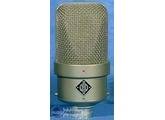Fiche technique
- Fabricant : Neumann
- Modèle : M-49
- Catégorie : Micros statiques à tube à large membrane
- Autres dénominations : m 49, m49
Source : http://recordinghacks.com/microphones/Neumann/M-49
The M 49 was a multipattern large-diaphragm tube microphone with an important new innovation: the mic’s pickup pattern could be adjusted remotely, by a dial on the power supply.
Another new innovation was that the mic maintained nearly equal sensitivity and output level across patterns — unlike the U-47, for example, which was 5dB hotter in Cardioid than Omni.
 Maintaining output level required a change in the polarization voltage circuitry. Whereas the U-47’s circuit would disconnect the capsule’s rear diaphragm in Cardioid mode, in the M 49 both diaphragms were always polarized — the front at a constant 60Vdc, and the rear from 0Vdc to 120Vdc. When set to Cardioid, the rear diaphragm polarization voltage was 0Vdc.
Maintaining output level required a change in the polarization voltage circuitry. Whereas the U-47’s circuit would disconnect the capsule’s rear diaphragm in Cardioid mode, in the M 49 both diaphragms were always polarized — the front at a constant 60Vdc, and the rear from 0Vdc to 120Vdc. When set to Cardioid, the rear diaphragm polarization voltage was 0Vdc.
Like its omnidirectional sibling, the M 50, the M 49 was initially released with a Hiller MSC2 tube, soon replaced by the Telefunken AC701 subminiature triode.
The two mics are nearly identical in appearance; the primary distinguishing cosmetic feature is the color of the “jewel” above the Neumann badge. On the M 49, the jewel is red.
Output impedance was wired at 200 Ohms from the factory. The product manual advised that “by changing two links on the output transformer, the amplifiers can be easily changed to 50 Ohms whereby the output voltage falls by 6dB.”
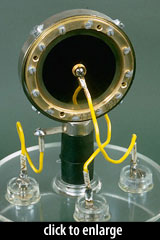 The capsule in the original version of the M 49 was Neumann’s PVC-diaphragm M7. This was subsequently replaced (as in the U47) with the Mylar-diaphragmmed K49. (The K49 was K47 capsule, identical in every respect but the name.)
The capsule in the original version of the M 49 was Neumann’s PVC-diaphragm M7. This was subsequently replaced (as in the U47) with the Mylar-diaphragmmed K49. (The K49 was K47 capsule, identical in every respect but the name.)
Production M 49 microphones incorporated the following major component changes:
- 1951 - Hiller MSC2 tube, M7 capsule
- 1954 - MSC2 replaced by Telefunken AC701
- 1956 - M7 replaced by K49 capsule
- 1958 - the M49b incorporated a new “BV11” transformer and some circuit-value changes, according to Klaus Heyne.
- 1961 - for the broadcast market, the M49 was fitted with a 7-pin Tuchel connector and redesignated M 249.
Klaus Heyne
All M49 models after 1957 had a “cardioid only” switch built in, to achieve a 4dB s/n improvement [as compared to setting the pattern] remotely, from the power supply.
The M 49 was discontinued in 1974.
M49 capsule/circuitry photo credit: Oliver Archut
The Neumann M 49 is also known as: M49, B-M49.
The mic was released in 1951.
Specifications| Frequency Response - OmnidirectionalClick Graph to Compare! |
|---|
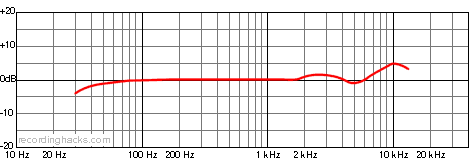 |
| Frequency Response - CardioidClick Graph to Compare! |
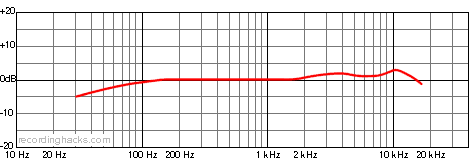 |
| Frequency Response - BidirectionalClick Graph to Compare! |
 |
| Pickup Patterns | Pads & Filters |
|---|---|
| Omnidirectional (n/a mV/Pa; 40 - 16,000 Hz) Cardioid (n/a mV/Pa; 40 - 16,000 Hz) Bidirectional (n/a mV/Pa; 40 - 16,000 Hz) |
| Capsule Dimensions | Impedance | SPL/Noise |
|---|---|---|
| Diameter n/a | 200 Ohms (Low) | Max SPL: 125 dB |
| Weight | Length | Max Diameter | Interface(s) |
|---|---|---|---|
| 800g (28.22oz) | 163mm (6.42'') | 80mm (3.15'') |
|
| Power Specifications |
|---|
|
Distribué par sennheiserfr
Avis utilisateurs
Vintage, et Remade
Publié le 26/08/12 à 06:20OVERALL OPINION
The Neumann M 49 is very versatile, I do prefer the M 49 over the M 50. Most people would argue that the M 50 is a better microphone but to me the M 49 has it beat by a long shot. The original M 49 was being made in the 70’s and since then has been discontinued so good luck getting your hand on one of the original ones, if you are lucky to find one it will cost a good amount. The original has been replaced with a newer version of the M 49 but has still adopted some of the same principles that the original stands by.
The Neumann M 49 has had minor changes over the years since they stopped making the original but it still continues to advance and keep up with all of the other condenser microphones around. All sound quality with the M 49 is remarkable and second to none. The original M 49 had a Hiller MSC tube on the inside I believe. The newer version of the M 49 does not use the Hiller MSC tube, it uses a Telefunken AC Sub-miniature tube. To most of this it really didn’t make a difference and you really wont hear a difference either. This is a very good microphone and I suggest anyone owning a studio should try to find the original one or the newer version. The microphone was made in 1951, and if you get the original you will have a great vintage condenser on your hands that has recorded many hits back in the 50’s and will give you a great sound in today’s music world.
OVERALL OPINION
I've been using the Neumann M 49 for a few years and it is truly a great sounding microphone. When compared to the modern day version of this mic, the Neumann M 149, it is warmer and definitely sounds more vintage since it is indeed older. This microphone is great for all sorts of situations, but for me it is best for recording vocals. It just has a really thick and warm sound that translates really well for recording vocals. It is such a good mic that it is fine for recording just about anything. I've used it on everything from acoustic guitars to using it as a room mic. The Neumann M 49 is a great combination of warmth and clarity and for this reason will sound good on everything that you want to record with it. Neumann is the best at what they do and truly do make the best microphones in the world. For this reason, the price of this mic is more expensive than most microphones and is designed for professional studio owners and engineers and definitely has the price tag of it. If you want a top notch tube condenser microphone, the Neumann M 49 is just about as good as it gets. I have no complaints at all about this microphone and is better than most microphones out there that aren't made by Neumann. If you can get your hands on this microphone and have the money to get one, you are definitely in good shape! The newer version of this mic, the M 149 is much more readily available but won't give you any relief on the price! All in all, the Neumann M 49 is an incredible mic that sounds every bit as good as you think it does.
Manuels et autres fichiers
Autres micros statiques à tube à large membrane Neumann
-
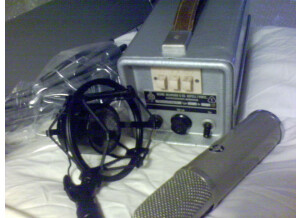
UM 57
Micro statique à tube à large membrane
-
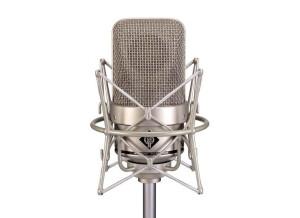
M 150 Tube
Micro statique à tube à large membrane
6 590 € neuf (6 offres) -
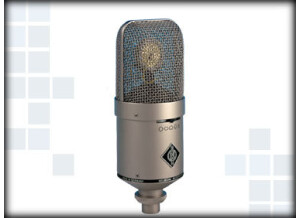
M 149 Jub Mono
Micro statique à tube à large membrane
-
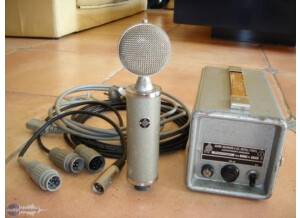
cmv551
Micro statique à tube à large membrane
-
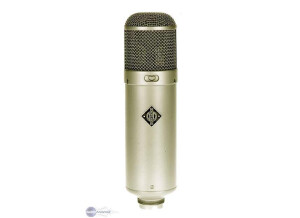
U 47
Micro statique à tube à large membrane
-
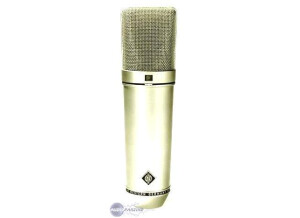
U 67
Micro statique à tube à large membrane
7 499 € neuf (8 offres)800 € d'occasion (1 offre) -
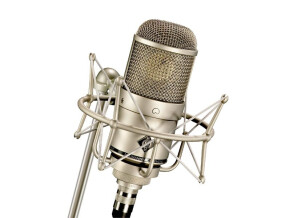
M 147 Tube
Micro statique à tube à large membrane
2 899 € neuf (9 offres)1 400 € d'occasion (4 offres) -
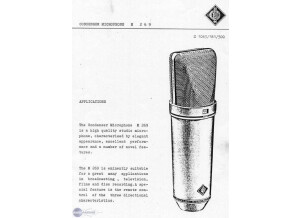
M269C
Micro statique à tube à large membrane
-
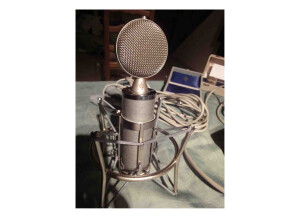
cmv 563
Micro statique à tube à large membrane
-
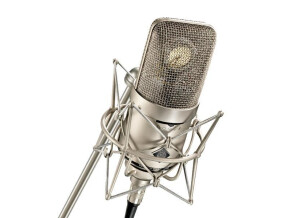
M 149 Tube
Micro statique à tube à large membrane
4 999 € neuf (8 offres)2 600 € d'occasion (3 offres)










